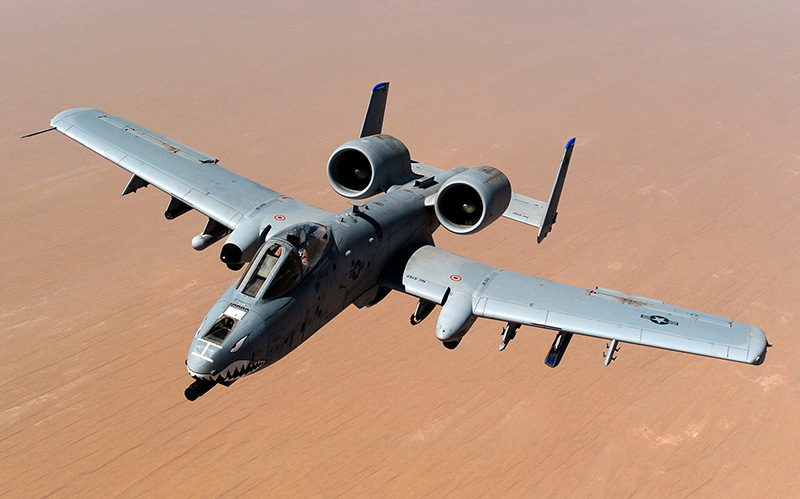
An A-10 Thunderbolt II from the 74th Fighter Squadron at Moody Air Force Base in Georgia flies over Afghanistan in this 2011 photo. (Photo by Master Sgt. William Greer/U.S. Air Force)
WASHINGTON – The Pentagon’s attempt to retire the A-10 fighter jet was based on insufficient information that did not fully consider vulnerabilities that could come from the loss of the “Warthog,” the Government Accountability Office said.
The GAO report, released Wednesday, also said that because of shortcomings in its evaluation process, the Air Force “cannot ensure that it has a reliable estimate of the cost savings it would generate by divesting the A-10” – the main justification for dropping the plane.
The report was welcomed by Arizona lawmakers and business leaders, who said it vindicated their fight to keep the A-10, a mainstay at Davis-Monthan Air Force Base, where 84 of the planes are based.
“There’s no replacement for the A-10’s unique ability to carry out close air support, including situations that require an ability to loiter, fly under weather and visually identify friendly and enemy forces,” said Rep. Martha McSally, R-Tucson, in a statement from her office. McSally was the first woman to fly the A-10 in combat.
Michael Varney, president and CEO of the Tucson Metro Chamber, said Davis-Monthan provides $1.5 billion in economic activity for the city of Tucson, which is why the chamber “has lobbied extensively in Washington, D.C., to protect the primary flying missions at Davis-Monthan, which is the A-10.”
The A-10 Warthog is a 1970s-vintage fighter that is heavily armed and heavily armored, making it ideal for flying low over a battlefield and targeting troops and armored vehicles below. Because it can fly low and slow, it is also well-suited for search-and-rescue missions.
The jet has received upgrades over the decades and supporters say it still has years of relevance.
Beginning with the fiscal 2015 budget, however, the Air Force proposed retiring the fleet as a cost-cutting move, saying it did not have the funds to maintain the aging A-10s while bringing on the next-generation F-35. Phasing out the A-10 would have saved $4.2 billion over five years, according to the Air Force, and its missions would be taken over by F-35s as they came into service.
But the GAO report said the Air Force “did not fully assess the cost savings and implications” from the move, saying it neglected to account for costs that would have to be paid to retire the A-10. At the same time, it said the savings could have been higher than estimated because the Air Force did not account for savings from canceled upgrades.
In its response to the report, the Air Force said that “the A-10 divestment was the most acceptable strategy to remain within the Air Force budget authority while controlling risk across all Air Force mission sets.” Air Force and Pentagon officials on Thursday declined to comment further on the report.
The GAO also said the Pentagon did not fully consider gaps in the fundamental roles fulfilled by the Warthog, including close air support and search and rescue.
“The A-10 aircraft also has unique capabilities not replicated in other Air Force fighters such as the F-16 and F-35,” the report said.
Additionally, the report found the plans to phase out A-10 squadrons would outpace the addition of F-35 squadrons, “with eight A-10 squadrons divested by the end of the 5-year budget plan but only six F-35 squadrons” in service.
But Congress has successfully blocked attempts to drop the A-10. The latest Air Force plan calls for an A-10 phase-out to begin in fiscal 2018, with the fleet fully retired by fiscal 2022 – a plan that Arizona lawmakers said they will continue to fight until they are convinced there is a better replacement.
The jet is especially relevant now because of emerging threats, they argue. Sen. John McCain, R-Arizona, said in a statement from his office that the A-10 “continues to play an important role in the fight against the Islamic State of Iraq and the Levant (ISIL) and supporting NATO’s efforts in Eastern Europe to deter Russian aggression.”
The report made three recommendations – all of which the Air Force disagreed with, saying in its response to the report that it already has procedures in place to do what the GAO wants.
But the GAO still said the Air Force and the Defense Department should “fully identify mission gaps, risks and mitigation strategies … before again proposing to divest its A-10 fleet.”